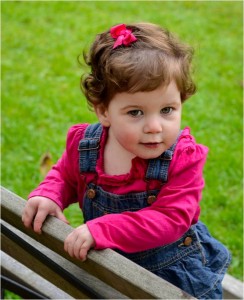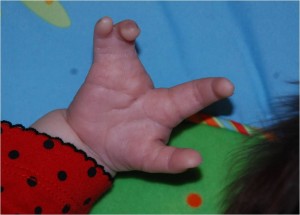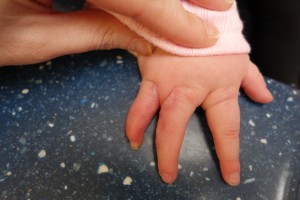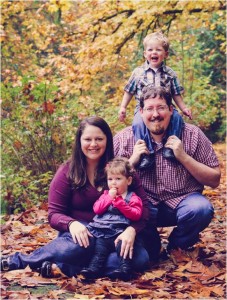Meet Olivia Rickert and Michile Smith: Two generations apart, but linked forever by their special hands.
 When Olivia Rickert was still in utero, an ultrasound at 20 weeks revealed that she had inherited a genetic mutation passed down from her mother and maternal grandmother. In Olivia’s case, the mutation was expressed as a cleft (split) hand. Though most kids born with this condition have no other health problems and can overcome their hand difference naturally or with surgery, Olivia’s mom (Stephanie Rickert) worried it might signal worse news. Stephanie had little outward sign of the mutation, but her mother, Michile Gormley Smith, was born with split hand/split foot absent long bone syndrome — claw-like hands and feet and legs missing tibia bones. (Smith was treated at Seattle Children’s starting in 1958 by pioneering orthopedist Dr. Ernest Burgess.)
When Olivia Rickert was still in utero, an ultrasound at 20 weeks revealed that she had inherited a genetic mutation passed down from her mother and maternal grandmother. In Olivia’s case, the mutation was expressed as a cleft (split) hand. Though most kids born with this condition have no other health problems and can overcome their hand difference naturally or with surgery, Olivia’s mom (Stephanie Rickert) worried it might signal worse news. Stephanie had little outward sign of the mutation, but her mother, Michile Gormley Smith, was born with split hand/split foot absent long bone syndrome — claw-like hands and feet and legs missing tibia bones. (Smith was treated at Seattle Children’s starting in 1958 by pioneering orthopedist Dr. Ernest Burgess.)
A dream team of specialty care
Cleft hand is rare — only one in one million children is born with it. When Smith was born more than 50 years ago, her parents had no advance notice of her condition. Thanks to strides in prenatal diagnosis and care, Olivia’s parents had the good fortune to be referred to Seattle Children’s Skeletal Dysplasia Clinic even before their daughter was born.
Once there, they received prenatal counseling with Michael Goldberg, MD, Suzanne Steinman, MD, and Ian Glass, MB ChB, MD — a dream team of pediatric-focused orthopedic, surgical and genetic specialists whose collaboration is unique in the region. Within four weeks of the initial ultrasound, the Rickerts were able to breathe a sigh of relief.
The team determined that the long bones in Olivia’s legs and arms were growing normally and only one hand was affected by the cleft. But it remained to be seen whether she would need surgery on her cleft hand once she arrived.
The ties that bind

After Olivia was born three months later in November 2012, she visited Seattle Children’s with her mom’s side of the family so the medical team could examine her mom, older brother, uncle and great aunt for physical tendencies toward clefting and other limb deficiencies.
“We know genetic mutations run in families, but not everyone is affected in the same way,” explains Steinman, an orthopedic surgeon dedicated to the repair of hands and arms at Seattle Children’s Hand and Upper Extremity Program — the only program of its kind in the region.
“In this case, we can see the mutation running from grandmother to daughter to granddaughter. Michile has the most extreme presentation with all four limbs involved; Stephanie’s is the mildest with a shorter-than-average big toe; and Olivia’s cleft hand is right in the middle of the spectrum. Each time an affected male or female in Michile’s genetic line has a child, there’s a 50/50 chance that their offspring will be born with some type of cleft or limb deficiency, and that’s a very important thing for Olivia and her descendants to know,” she said.
Improving function for a full life

Steinman sees only a couple of new cases of cleft hand each year, including Olivia whose right hand was missing its middle finger (cleft) and had a fused ring and pinkie finger (syndactyly).
“We help kids like Olivia improve their overall hand function and go on to do absolutely everything their peers can do,” she said.
In the end, Olivia did need surgery to separate her ring and pinkie fingers. Without it, her ring finger would stay tethered to the pinkie and eventually curl under to match the pinkie’s length — a situation that would prevent her from being able to hold objects with those two fingers.
In December 2013, when Olivia was 13 months old and still young enough for her brain to acclimate easily to newly separated fingers, Steinman performed the delicate surgery at Seattle Children’s Bellevue Clinic and Surgery Center. After confirming that each finger had its own blood supply, she used skin grafted from Olivia’s wrists to cover the exposed parts of the separated digits.
After the surgery, Seattle Children’s occupational therapists helped disperse scar tissue and get Olivia’s fingers moving again. As she gets older, if Olivia decides she wants to play sports or be in the school band, the OT team will be there for her to help make modifications to sporting equipment or musical instruments.

Steinman says her goal is to treat the whole child and get them to a place where they can just enjoy being kids. “Childhood should be spent on the playground and I do my best to help my patients get back there as quickly and as safely as possible. I’m so pleased that Olivia’s surgery will give her the freedom to participate in any activity she chooses,” she said.
Limb Differences Social: Meet other children with limb differences and their families: Sunday, March 30, 2014, from 1 to 4 p.m. at Seattle Children’s main campus. Park in the Ocean garage (parking is free) and enter on Ocean floor 7. The event is in Small Dining Room 3 across from the cafeteria seating area. All are welcome.
Resources
- Seattle Children’s Rehabilitation Medicine
- Lucky Fin Project
- Outdoors for All
If you’d like to interview Olivia’s family or Dr. Steinman, please contact Seattle Children’s PR team at 206-987-4500 or [email protected].

